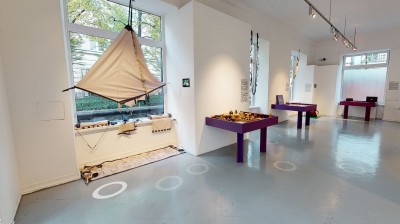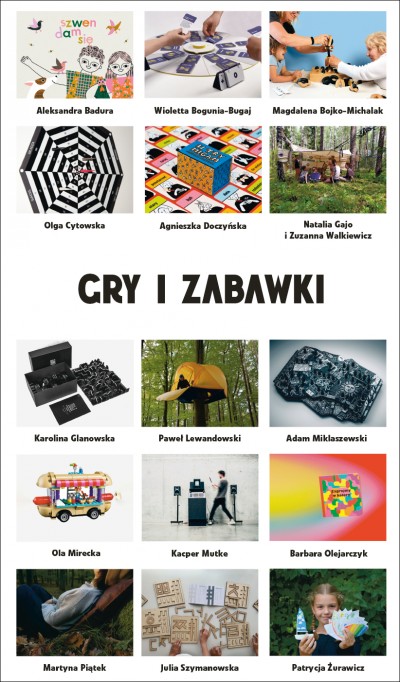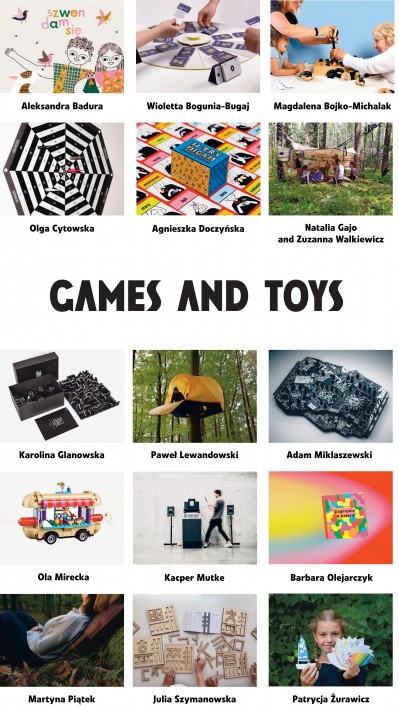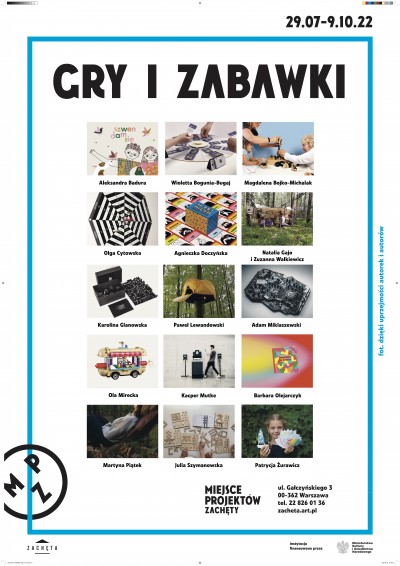Games and toys
29.07 – 09.10.2022 Games and toys
artists and designers: Aleksandra Badura, Wioletta Bogunia-Bugaj, Magdalena Bojko-Michalak,
Olga Cytowska, Agnieszka Doczyńska, Natalia Gajo and Zuzanna Walkiewicz, Karolina Glanowska, Adam Miklaszewski, Ola Mirecka, Kacper Mutke, Paweł Lewandowski, Barbara Olejarczyk, Martyna Piątek, Julia Szymanowska, Patrycja Żurawicz
curator: Magda Kardasz
collaboration: Monika Kopczewska
design of exhibition: Jacek Malinowski
exhibition production: Monika Kopczewska, Michał Kubiak
Games and toys is an exhibition presenting games that entertain, teach and connect generations, as well as toys and objects created for recreation by young Polish designers. These projects can be used by both children and adults. They are from the analogue and virtual worlds. Many are educational, supporting intellectual development and the acquisition of new skills, while others are more sporting in nature. They all allow you to spend your leisure time usefully, develop your creativity in interaction with other people and sometimes even break down barriers.
ALEKSANDRA BADURA, I’M A WANDERER. A CHILD IN AN ADULT WORLD — A MOBILE APP PROJECT TO SUPPORT CHILDREN’S SENSE OF AGENCY
The aim of the project was to create a mobile tool for pre-school children that would not only be used for carefree play, but also teach important skills. I focused on developing the so-called soft skills that make a real difference to feeling happy in adulthood. Staying in touch with a child psychologist, I created an app design where, by performing simple tasks, children learn to make their own decisions, can observe the cause-and-effect sequences of their actions and strengthen their sense of agency.
Aleksandra Badura — (born 1994), is a graduate in industrial design from the Academy of Fine Arts in Kraków (2019). She has been professionally involved in brand design, corporate identity and digital product development. More recently, she has also been involved in illustration, mainly for the youngest audiences.
WIOLETTA BOGUNIA-BUGAJ, FAMILY CHATTER
The board game helps to build and maintain family ties and is a kind of link between household members. It consists of a round board with a shuffle wheel, category cards, task cards, special cards, scoring blocks and game instructions. Children learn by modelling, i.e. the models they draw from their immediate environment, which shape social and family behaviour in adulthood. One important factor is proper communication within the family.
Wioletta Bogunia-Bugaj — (born 1992), graduate in industrial design from the Jan Matejko Academy of Fine Arts in Kraków; since 2021, pursuing postgraduate studies at the Jan Frycz Modrzewski Academy in Kraków.
MAGDALENA BOJKO-MICHALAK, TOTEMS — A GAME FOR MANY GENERATIONS
The aim of the Totems game is to activate seniors and integrate the generations. Observing a family: the grandmother’s dementia, the development of her toddler niece and their relationship with each other inspired me to create a tool for understanding between the oldest and youngest family members. The totems consist of children’s blocks — spatial forms — that encourage constructional exploration and stimulate eye-hand movement, and a universal game for seniors, designed for daily mental exercises as well as social gatherings.
Magdalena Bojko-Michalak — (born 1994), defended her BA in Fashion Design at the School of Form in Poznań, diploma in design — at the University of Arts in Poznań. She is most interested in social action, as well as conscious and sustainable design. In the future, she would like to donate the first copies of Totems to care homes for senior citizens.
OLGA CYTOWSKA, FATE — AN ARCADE GAME INSPIRED BY THE POPULAR DARTS, IN A MODIFIED FORM AND WITH DIFFERENT RULES
What’s more important, playing the game or winning? Do we rely on chance or do we decide our own fate? Practice is what will help you achieve your goal. The game is a pretext to reflect on our everyday life — the pursuit of goals, life choices and what is most important to us. And also the everydayness of accidents and coincidences. Game, fate, life — it’s all intertwined here.
Olga Cytowska — (born 1988), graduate of the Faculty of Design at the Academy of Fine Arts in Warsaw. She works professionally in graphics, from corporate identity design to illustration and abstract paintings.
AGNIESZKA DOCZYŃSKA, SIGN AND PLAY
Sign and Play is a card game, introducing the world of Polish Sign Language at a basic level. Participants show and guess sign gestures to form a sentence from them at the end of the game. The game format enhances learning and makes language acquisition easy and enjoyable.
Agnieszka Doczyńska — (born 1996), graduate of the Faculty of Graphics at the Academy of Fine Arts in Warsaw (2021). She works in photography, editorial graphics and design in the broadest sense. Her work focuses on important social and environmental issues. She is currently studying visual communication at the Universität der Künste in Berlin.
NATALIA GAJO, ZUZANNA WALKIEWICZ, OPNIAKI — FOREST PLAYGROUND
Opniaki are multifunctional play elements among trees designed for a group of ten children and one educator, such as summer camp participants. The project draws on the currents of outdoor education and the tradition of alternative playgrounds. The children themselves hang up the set according to their own ideas — it can be used for climbing, swinging or building a fort. To start playing, the individual parts need to be attached to tree trunks, making the set an excuse to go out into the woods. Opniaki encourage interaction with nature, familiarise children with the forest and teach them respect for it.
Natalia Gajo — (born 1995), a recent graduate of the Faculty of Design at the Academy of Fine Arts in Warsaw, she also studied at the Akademie der Bildenden Künste in Stuttgart. She is involved in product design and visual communication. She believes that empathy is the key to design.
Zuzanna Walkiewicz — (born 1993), studied ethnology and cultural anthropology before entering the Faculty of Design at the Academy of Fine Arts in Warsaw. In her work, she tries to creatively use the ethnographer’s workshop and the social researcher’s approach. She is interested in craft and design focused on renewable materials.
KAROLINA GLANOWSKA, THE INVISIBLE ISLAND
The Invisible Island board game is an attempt to address the lack of integration between blind and sighted people. Playing together makes it possible to break down mutual prejudices and get rid of stereotypes. Experts in game development and those involved in designing for visually impaired people were consulted on the project. Prototypes were made and tested several times by blind and sighted users.
Karolina Glanowska — (born 1996), runs GLAN ART Art Studio, focusing on projects related to graphic design, photography and film in the broadest sense. During her studies at the Academy of Fine Arts in Katowice, she was involved in poster design. The Invisible Island is her diploma work, prepared at the graphic design studio under Tomasz Bierkowski, where she obtained her Master of Arts degree (2020).
PAWEŁ LEWANDOWSKI, HUBA — TREE TENT
The project makes possible to sleep up high in a tree without using rope access techniques. A user can hang a tent and enter it safely without having completed any rock climbing course. The stiff platform provides a firm support and comfort, while staying at high altitude. This, along with a flysheet, enables one to photograph animals discretely and allows to sleep in a tree. Paweł Lewandowski — (born 1984), product designer as well as craftsman, maker of handmade knives. In 2009, he graduated with a master’s degree from the Faculty of Management at the University of Gdańsk. In 2019, he defended his diploma at the Faculty of Architecture and Design at the Academy of Fine Arts in Gdansk with the project Huba. His design work combines altitude and hiking experience with design.
ADAM MIKLASZEWSKI, GOLDEN DAWN — EXPERIMENTAL SYNTHESIZER
The electronic device I designed and made is designed for sound creation and experimentation. Golden Dawn is built from printed circuit boards, which serve not only as necessary technical components but also as artistic matter on which I have placed many cryptic illustrations. In addition to the Golden Dawn synthesiser itself, the series also includes three simpler and smaller units that are fully compatible with the modular synthesiser, but also function as separate instruments.
Adam Miklaszewski — (born 1997), studied at the Faculty of Graphic Arts at the Academy of Fine Arts in Warsaw (2016–2021). He is interested in the synthesis of printmaking techniques with other art disciplines, such as designing devices that are a combination of his illustrations and electronic circuits to generate and modulate sound. He builds and sells synthesisers and other DIY music equipment.
OLA MIRECKA, LEGO AND SENSITIVE DOG LEGO: Friendship House, Amusement Park — Hot Dog Van, Heartlike Skate Park, Puppy Parade, Icecream Van
SENSITIVE DOG is an interactive sculpture. Just like a real dog it reacts to human touch. Motion is a source of information and technology allows us to imitate natural behaviour. The author is interested in the way we read motion and the object we interact with and how it could impact the future of design.
Ola Mirecka — (born 1986), is a Polish designer based in Denmark, graduate from the Warsaw Academy of Fine Arts (2010) and the Royal College of Art in London (2012) currently running her multi-disciplinary studio creating objects and experiences often combining traditional craft with new technologies. Since 2014 she has been designing products for the LEGO Group. Through hands-on, experimental and interactive processes, she is investigating how play can be used as a tool for innovation and how being playful can help to solve problems in the grown-up world.
KACPER MUTKE, SOUND OBSERVATORY — INTERACTIVE EDUCATIONAL MULTIMEDIA INSTALLATION
An interactive educational multimedia installation is used to observe sound. It consists of two parts: an animation providing the user with basic knowledge of the physical properties of sound waves and an interactive part. By generating sound with a controller — a synthesiser — we receive an image of the sound produced, interpreted through a specially adapted vectrex screen. The experience brings the viewer closer to the nature of sound and demonstrates the logic of images of harmonic vibrations.
Kacper Mutke — (born 1994), completed his master’s degree in 2019 at the Multimedia Activities Studio at the Academy of Fine Arts in Katowice. His areas of activity include broadly understood visual experimentation, creative programming, generative art, multimedia installations, animation, painting and VJing. Co-founder of the tajny_projekt art collective.
BARBARA OLEJARCZYK, LET’S PLAY WITH COLOURS
Let’s Play with Colours is a book for the young and old. As a graphic designer I often find myself overstimulated by images. But after all, children have it even worse — illustrations ‘shout’ to them from an early age and define their reality. Does it have to be this way? A children’s book without illustrations? It makes sense — let’s put our imagination to work and give our eyes a rest. Barbara Olejarczyk — (born 1992), works in painting and graphic design. She runs Krzyżówka, a grassroots initiative and open studio for printmaking. In 2018, she graduated from the Władysław Strzemiński Academy of Fine Arts in Łódź.
MARTYNA PIĄTEK, FOR/REST
The for/rest project is a redefined form of mobile seating that was inspired by a Japanese practice called shinrin-yoku, literally translated to mean ‘forest bathing’. In Japan, this practice has the rank of medical therapy and is prescribed by specialists as a remedy for stress resulting from overwork. It consists of careful walks in the forest, during which, in addition to walking, the smell, taste and touch of the surrounding nature become important. The seat is intended to encourage walkers to calm down and build a closer relationship with nature, without restricting their freedom of movement — that is why its form resembles a sack that can be thrown over the back.
Martyna Piątek — (born 1993), graduate of master’s studies at the Faculty of Design at the Academy of Fine Arts in Katowice and of the BA studies at the Faculty of Interior Design at the Jan Matejko Academy of Fine Arts in Kraków. Product and interior designer. Winner of the 2020/21 Mazda Design Experience competition (for for/rest). She is a lecturer at the Academy of Fine Arts in Katowice.
JULIA SZYMANOWSKA, HANGUL — A KOREAN LANGUAGE EDUCATIONAL TOY DESIGN
The project is intended to help in learning the Korean language. It is not a simple language, but it is becoming increasingly popular thanks to the spread of Korean pop-culture, especially among young people. Learning the language should start with learning the alphabet — hangul. It’s construction inspired me to create an educational toy. The target group for this toy is early school-age children who learn through play. I would like to encourage them to get to know other languages and cultures.
Julia Szymanowska — (born 1998), artist, designer. Since 2018, she has been studying design at the Magdalena Abakanowicz University of Arts in Poznań.
PATRYCJA ŻURAWICZ, OPTIBOT — A TOY FOR LEARNING THE BASICS OF SAILING THEORY USING PROGRAMMING FUNDAMENTALS
Optibot is a board game aimed at children and young people. It is based on play, through which the participant consolidates the acquired theoretical knowledge and applies it in practice. The robot acts as an interactive game pawn, moving along a pre-set track and responding to commands set by the player along its route. The robot’s housing reflects the key features of the Optimist class sailboat — the most popular yacht among underage sailing students.
Patrycja Żurawicz — (born 1996), graduate in design from the Academy of Fine Arts in Gdańsk. She completed her master’s degree at the Shipbuilding Architecture Design Studio. She is guided by empathy in design and everyday life.
29.07–9.10.2022 Tuesdays–Sundays 12–8 p.m.
ul. Gałczyńskiego 3, 00-362 Warsaw
+48 22 826 01 36
Games and toys
29.07 – 09.10.2022
Zachęta Project Room
ul. Gałczyńskiego 3, 00-362 Warsaw
See on the map
Godziny otwarcia:
tuesday–Sunday 12–8 p.m.
free entry



